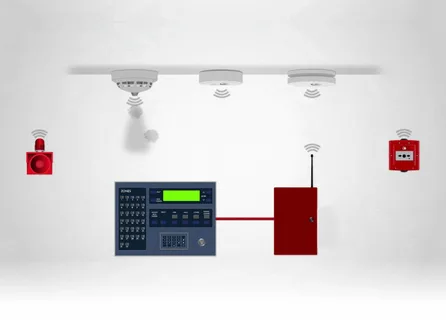The wireless fire detection systems market is set for robust growth, rising from a valuation of USD 1.62 billion in 2025 to USD 3.1 billion by 2035, expanding at a compound annual growth rate (CAGR) of 7.6%. This notable expansion is largely attributed to the increasing adoption of smart building technologies, growing awareness around life safety compliance, and significant advancements in sensor networks and wireless communication. Sectors such as commercial real estate, residential complexes, industrial plants, and healthcare facilities are driving the market forward with heightened investments in reliable, scalable, and cost-efficient fire detection infrastructure.
Wireless fire detection systems offer numerous advantages over traditional wired systems, including faster installation, lower maintenance costs, flexible scalability, and minimal structural disruption. These features make them ideal for retrofitting older buildings or deploying in hard-to-wire spaces, while their integration with IoT platforms and cloud-based monitoring enhances situational awareness, fault diagnostics, and emergency response capabilities. With evolving regulations and insurance mandates pushing for higher standards in fire safety, wireless systems are rapidly becoming the standard across multiple applications.
Get Ahead with Our Report: Request Your Sample Now!
https://www.futuremarketinsights.com/reports/sample/rep-gb-17830
Market Trends
-
Rapid shift toward IoT-enabled fire detection networks for centralized monitoring and alerts.
-
Adoption of battery-powered wireless smoke, heat, and flame detectors.
-
Integration of wireless fire systems with building management and automation systems.
-
Development of AI-driven fire prediction algorithms using sensor data analytics.
-
Surge in retrofitting projects for legacy buildings with modern wireless fire detection technology.
Driving Forces Behind Market Growth
-
Stringent fire safety codes and regulatory frameworks across commercial and residential sectors.
-
Expansion of smart city infrastructure and connected buildings requiring modern safety systems.
-
Growing awareness and enforcement of occupational health and safety standards.
-
Increased demand in healthcare and manufacturing for scalable fire protection solutions.
-
Technological advancements enabling longer battery life, improved signal range, and interference resistance.

Challenges and Opportunities
-
Challenges:
-
Concerns over signal interference and network reliability in densely built environments.
-
Initial investment costs for smart systems may deter small-scale building owners.
-
Need for certification and compliance with varying regional fire safety standards.
-
Potential battery maintenance issues in remote or high-traffic locations.
-
-
Opportunities:
-
Rising interest in cloud-based fire monitoring platforms offering real-time alerts and remote diagnostics.
-
Integration of wireless fire detection into multi-hazard safety systems, including gas and intrusion detection.
-
Increased adoption in temporary or mobile structures, such as event venues or construction sites.
-
Development of mesh-networked sensors to enhance coverage and redundancy.
-
Expansion into developing regions with minimal existing safety infrastructure.
-
Recent Industry Developments
-
Introduction of EN-54 compliant wireless fire alarm systems to meet European fire safety standards.
-
Launch of dual-sensor detectors combining smoke and heat sensing in compact, wireless units.
-
Collaborations between smart home platform providers and safety equipment manufacturers for integrated offerings.
-
Upgrades to battery-powered, self-testing detectors with extended life and diagnostic capabilities.
-
Deployment of 5G-compatible wireless fire safety networks to support faster data transmission and device integration.
Exhaustive Market Report: A Complete Study
https://www.futuremarketinsights.com/reports/wireless-fire-detection-systems-market
Regional Analysis
-
North America:
-
Strong adoption of wireless fire detection in smart buildings, healthcare, and industrial automation.
-
Stringent building safety codes and insurance mandates driving early implementation.
-
High level of integration with intelligent building systems and emergency communication platforms.
-
-
Europe:
-
Mature market with strict fire protection regulations and early uptake of wireless systems in urban infrastructure.
-
Increased demand for retrofitting historic and high-rise buildings with non-invasive fire detection systems.
-
Focus on green building certifications boosting deployment of energy-efficient wireless devices.
-
-
Asia-Pacific:
-
Fastest-growing regional market, led by urbanization, infrastructure investments, and smart city initiatives.
-
High demand in China, India, Japan, and Southeast Asia for scalable and cost-effective safety systems.
-
Government-led programs encouraging installation of fire detection systems in public and private buildings.
-
-
Latin America and Middle East & Africa:
-
Growing awareness and policy shifts promoting fire safety infrastructure.
-
Investments in commercial and industrial zones creating new deployment opportunities.
-
Potential for wireless solutions in remote, temporary, or structurally complex settings where wired systems are impractical.
-






